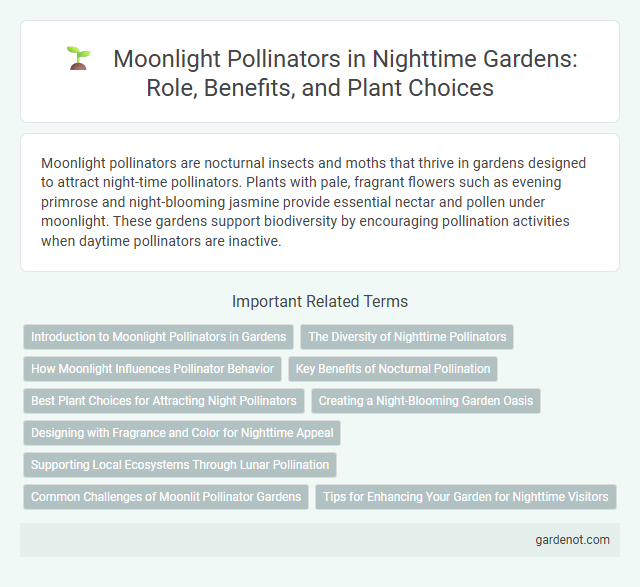Moonlight pollinators are nocturnal insects and moths that thrive in gardens designed to attract night-time pollinators. Plants with pale, fragrant flowers such as evening primrose and night-blooming jasmine provide essential nectar and pollen under moonlight. These gardens support biodiversity by encouraging pollination activities when daytime pollinators are inactive.
Introduction to Moonlight Pollinators in Gardens
Moonlight pollinators are nocturnal creatures, such as moths and bats, that play a crucial role in the pollination of night-blooming flowers in gardens. These pollinators are attracted to white or pale-colored blooms with strong fragrances that open after sunset, facilitating cross-pollination in the absence of daylight insects like bees. Incorporating moonlight pollinator-friendly plants enhances biodiversity and aids in the reproduction of specific plants adapted to nighttime pollination patterns.
The Diversity of Nighttime Pollinators
Moonlight pollinator gardens support a diverse range of nighttime pollinators, including moths, bats, and nocturnal beetles, each playing a vital role in ecosystem health. These pollinators rely on fragrant, pale-colored flowers like evening primrose, moonflower, and jasmine, which emit stronger scents during the night to attract their specific species. Emphasizing plant diversity and night-blooming species enhances pollination rates and promotes biodiversity within nocturnal habitats.
How Moonlight Influences Pollinator Behavior
Moonlight significantly influences pollinator behavior by extending foraging hours for nocturnal pollinators such as moths and bats, enhancing their ability to locate flowers in low-light conditions. Studies reveal that increased lunar illumination improves navigation and flower detection, leading to more efficient pollination activities during night hours. This natural light source plays a crucial role in supporting biodiversity and maintaining ecological balance within pollinator gardens.
Key Benefits of Nocturnal Pollination
Moonlight pollinator gardens enhance biodiversity by attracting nocturnal pollinators such as moths, bats, and beetles, which play a crucial role in the reproduction of night-blooming plants. These gardens support ecosystem health by ensuring pollination continuity when diurnal pollinators are inactive, increasing plant species diversity and fruit yield. Nocturnal pollination also promotes genetic variation and resilience in native plant populations, contributing to balanced and sustainable habitats.
Best Plant Choices for Attracting Night Pollinators
Moonlight pollinator gardens thrive with night-blooming plants like evening primrose, night-blooming jasmine, and nicotiana, which emit strong fragrances to attract moths and bats. White or pale-colored flowers enhance visibility in low light, improving pollinator efficiency during dusk and nighttime hours. Selecting native species such as evening primrose (Oenothera biennis) supports local ecosystems and promotes effective pollination by nocturnal insects.
Creating a Night-Blooming Garden Oasis
Moonlight pollinator gardens feature night-blooming plants such as evening primrose, moonflower, and night-scented stock, attracting moths, bats, and nocturnal bees essential for nighttime pollination. Incorporating white or pale-colored flowers enhances visibility under moonlight, optimizing the garden's appeal to night pollinators. Strategic placement near water sources and shelter supports diverse nocturnal pollinator species, fostering a thriving nighttime ecosystem.
Designing with Fragrance and Color for Nighttime Appeal
Moonlight pollinator gardens are designed to attract nocturnal pollinators like moths and bats by incorporating fragrant, white or pale-colored flowers that reflect moonlight for enhanced visibility at night. Plants such as night-blooming jasmine, white evening primrose, and moonflower emit strong scents after dusk, essential for guiding pollinators in low-light conditions. Selecting a variety of bloom times and layering plants ensures continuous nighttime fragrance and color, maximizing pollination efficiency during moonlit hours.
Supporting Local Ecosystems Through Lunar Pollination
Moonlight pollinators, such as moths and nocturnal beetles, play a crucial role in supporting local ecosystems by enabling nighttime pollination of specific plants adapted to lunar cycles. These pollinators enhance biodiversity by facilitating the reproductive success of night-blooming flowers, which in turn supports a wide range of wildlife dependent on these plants. Integrating moonlight pollinator-friendly species in gardens improves ecosystem resilience and promotes sustainable biodiversity conservation.
Common Challenges of Moonlit Pollinator Gardens
Moonlight pollinator gardens often face challenges such as insufficient night-blooming plant varieties that attract nocturnal pollinators like moths and bats, limiting biodiversity. Light pollution disrupts the natural behavior of these pollinators, causing reduced pollination efficiency and habitat avoidance. Soil quality and moisture retention also impact the growth of night-blooming flowers essential for a thriving moonlit pollinator ecosystem.
Tips for Enhancing Your Garden for Nighttime Visitors
Moonlight pollinators such as moths, bats, and nocturnal bees are drawn to fragrant white or pale-colored flowers that reflect moonlight, making your garden more inviting after dark. Incorporate night-blooming plants like evening primrose, moonflower, and jasmine to provide nectar sources that thrive in low light conditions. Avoid bright artificial lighting by using soft, warm lights or solar lanterns to minimize disruption, ensuring effective nighttime pollination and enhancing the health of your garden ecosystem.
Moonlight pollinator Infographic

 gardenot.com
gardenot.com